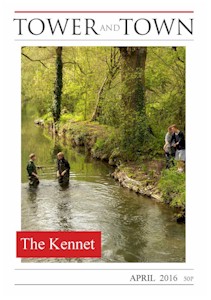

Tower and Town, April 2016 (view the full edition) (view the full edition)Clergy Letter: Water - Friend Or FoeGiven that water is such an essential part of life and given that religions seek to help us make sense of life, water is bound to have a part to play in religious traditions. And of course it does. It is water’s life-giving properties as well as its powers of cleansing and purifying that allow so many different rituals to be built around it. So much of what we say about water can be understood in both a literal and symbolic way. Whether it is free flowing or stagnant, whether it is clean or dirty, whether it cascades or accumulates, water’s condition can cast light on our own. No wonder it is so beloved of artists and poets as well as the religious. Looking at the different contributions about the Kennet allows the reader to see that the river is understood as a blessing to the town and countryside surrounding Marlborough. The water of the Kennet is seen as benign. Had the compiler of this issue of Tower & Town gone on tour to Cumbria in December and commissioned a series of articles about the local rivers there, the contributions would have been altogether different. Destruction, flooding and homelessness caused by water flowing out of control would have made it clear that water is a threat. The ambiguity of water is captured very clearly in the first two chapters of the Bible, Genesis Chapters 1 and 2, the two different accounts of Creation. In Chapter 1 water covers everything and dry land appears out of the waters once God gathers the waters into one place on the third day. In Chapter 2 there is no life until the Lord God causes rain to fall on the ground which then allows man to be formed from the dust of the earth. In the first account, then, water is malign; it is out of the chaos of flood that dry land emerges, whereas in the second account, water is life giving and benign. These two traditions, conveniently signalled by each having a different way of addressing God (‘God’ and ‘Lord God’), are understood to have emerged from two very different geographical areas – Mesopotamia and the Desert. Mesopotamia, the land between the rivers Tigris and Euphrates, was prone to flooding and its inhabitants were therefore aware of the dangers of water, whilst the desert tradition would see water as creative. It is interesting to note that in Christian Baptism, these two understandings of water, the destructive and the creative, come together. Baptism, which will often involve total immersion in water, represents a dying to an old way of life and the commencement of a new and enhanced life as the old is washed away. Andrew Studdert-Kennedy |